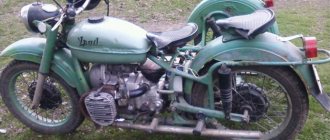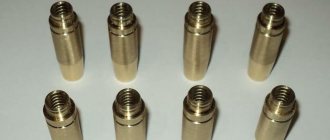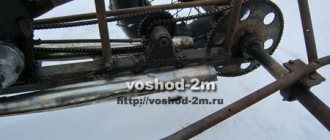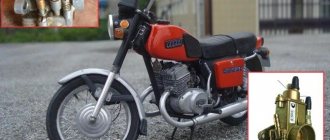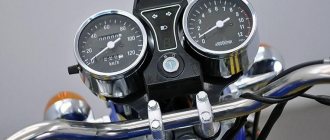The Dnepr MT 11 motorcycle comes from the Soviet Union, which was produced at the Kiev Motorcycle Plant. This heavy equipment was created to overcome difficult rural roads, transport goods to hard-to-reach settlements and tow small trailers. Thanks to the sidecar drive and reverse gear, the Dnepr motorcycle had high maneuverability, maneuverability and was an indispensable assistant in the household. Nowadays, tuning the Dnepr motorcycle does not lose popularity due to its ease of repair, the availability of accessible spare parts, and also falls under the “Retro” category, which is becoming more and more popular every year.
In this article we will tell you why Dnepr tuning is so interesting to this day. We will also talk about tuning the Dnepr engine, increasing power, maximum speed, and improving appearance.
A little history
The progenitor of the “Soviet Harley” appeared in the late 20s of the twentieth century.
At first it was a model designed by Mozharov on the basis of IZH and PMZ, but with a heavy frame and a 1200 cc engine that consumed a lot of fuel, it had a power of only 24 HP and lost control at speeds above 60 km/h. Therefore, it was decided to adopt European experience and use the advantages of the BMW R-71. Naturally, the German was not repeated completely, but only borrowed some ideas, adapting them to the realities of the USSR. In particular, they installed a double-disc clutch, increased the gear ratio and tank volume, increasing cross-country ability.
Where it all began
The production of motorcycles in Russia, or more precisely, in the USSR, began in the late 20s of the last century. The IZH and PMZ models, designed by designer Mozharov, had a heavy stamped frame and a huge 1200 cc engine, which nevertheless produced only 24 hp. With. At the same time, controllability disappeared already at 60 km/h.
Then, according to one version, third-party developments were used. In pre-war Germany, several models of the BMW R-71 motorcycle and drawings for them were purchased. According to the second version, the motorcycles were imported from Sweden. Having disassembled and modified the German cars to suit Soviet realities, the devices began to be produced at the Moscow and Gorky factories. During the war, production was evacuated to Irbit, in the Sverdlovsk region.
Be that as it may, the German R-71 became the progenitor of the serial M-72. The Soviet analogue was not a complete copy of the BMW: instead of a single-disc clutch, a double-disc clutch was installed, the tank volume became larger, the gear ratio was increased, which made it possible to more effectively overcome obstacles that are often encountered to this day in our country. We can say that this was the first tuning of the Ural. At that time, it wasn’t even “Ural”, but “Irbita”. Only with the M-62 model did motorcycles acquire their permanent name.
What can be tuned in Dnepr?
At the time these motorcycles were released, their quality was at the highest level, so all the components and the design itself still actively serve all owners. But modern requirements for appearance and some technical characteristics force us to carry out cosmetic and internal modifications to the motorcycle. Of course, you can do the tuning of the Dnieper with your own hands, but if you don’t have enough knowledge, workshops are open in most cities where people are probably knowledgeable in modernizing Soviet motorcycles.
There are basic elements that need to be changed when tuning, and in this model the following elements can be improved or even replaced:
- exhaust pipe;
- almost the entire chassis, in particular the windshield, roll bars;
- engine;
- front fork.
You can also briefly discuss the refinement of each element. For example, to tune the exhaust system, you will need to install a forward flow system and nickel elbows, which you can do yourself. External tuning will contain a lot of chrome parts, so tuning the Dnepr engine will involve a polishing process. If you upgrade these two parts, your motorcycle will not only look great, but it will also sound great.
As for technical modernization, the above recommendations can be supplemented by installing a fifth gear on the Dnepr. It is unlikely that you will be able to do this kind of work yourself, so it is better to turn to specialists with experience. But the result will be justified; your vehicle will have reverse gear. But even this is not where the basic tuning ends, because some Dnepr models, depending on the year of manufacture, can be improved by installing an electric starter.
Current state of affairs
Today the release is aimed at the foreign market. More than 95% of models are sold not in Russia, but in the USA and Canada, European countries, and the Asian market is becoming increasingly important over time. In South Korea or Japan, for example, there are still no worthy competitors in the sector of transport with a cradle; this niche is relatively unoccupied; there are perhaps Chinese replicas that have been copying BMW since the 50s, but they do not have the same status at all.
The total sales volume, if we count from the times of the late USSR, has long exceeded 3,000,000 copies, and this figure continues to grow. This makes it clear why you can so often hear the name “Soviet Harley” - people make the analogy based on popularity, and not on fit or appearance.
Naturally, there are many who want to first buy a legend, if only because of its glorious name, and then, after several years of operation, somehow update, refresh, and improve it. We are just moving on to possible changes.
What do you need to know when tuning?
If you have an MT Dnepr motorcycle that is several decades old, you should be aware of its main disadvantage - the fuel system. Unfortunately, this model from KMZ did not receive an ideal fuel system, so many will be interested in improving this characteristic through tuning. Also, Dnepr owners will be interested in improving the oil system by installing a high-quality oil filter.
Basics and tuning options
The “King of the Road,” as fans call it, can be converted into either a sport or a classic (chopper). The last option is the most popular, because it better suits the characteristics of the motorcycle.
A distinctive feature of choppers is the elongated frame , with which do-it-yourself tuning of the Dnieper begins. After welding, the frames are usually sandblasted until they are completely shiny. When the pendulum is lengthened, the rear wheel moves back 7-10 cm, and the front fork is lengthened no more than 15 cm from the standard version. The inclination of the latter is selected based on considerations of convenience and safety. Lengthening the pendulum can be done in a tuning workshop, for example here, or you can do it yourself using video instructions.
If possible, shock absorbers are replaced with lighter, chrome-plated ones. The fenders and their fastenings, side support, driver's footrests, kick starter and headlight are also chrome-plated. The engine is polished until it fully matches the chrome elements.
Tuning the exhaust system is often achieved by installing nickel-plated elbows and forward flow systems. Such an innovation, firstly, will complement the attractiveness of the appearance, secondly, it will improve (albeit not significantly) the performance of the engine, and thirdly, it will give the engine sound a dense, bassy tone.
Tuning a Dnepr motorcycle also involves installing the following modules:
- The tachometer gives the bike a more “serious” look and gives its owner ease of operation.
- The starter modernizes the unit and adds practicality to it.
- Fifth gear - a new 5-speed gearbox, or replacing reverse gear with a new speed, together with a new gearbox, can raise the speed limit by a couple of tens of km/h.
Increasing the bike's speed limit is also achieved by lightening its structural components. For example, a gas tank from a Honda rebel 250, which will also complement the classic “road monster” style.
Carburetors and ignition
Tuning a Ural motorcycle engine affects all engine systems, including ignition and carburetors. It is recommended to read the information: how to properly configure Ural carburetors. The standard ignition is so outdated that it is not even suitable for everyday driving, let alone anything else. It is desirable to install a microprocessor ignition with the possibility of an automatic advance angle. This article will help you set up the electronic ignition system. Ideally, such an ignition would be installed with a programmable controller with the ability to adjust the firmware. Such ignition systems have another useful feature - speed cut-off. This will prevent over-torque of a heavily boosted engine. Well, for maximum spark strength, in combination with a new ignition, you can use a coil from the Oka or Gazelle. Branded high-voltage wires with silicone insulation and internal resistance are required, for example from Tesla from VAZ 2108. They will ensure an uninterrupted spark in any weather and eliminate the possibility of spark breakdown to ground. As for carburetors, you will need to install Japanese vacuum carburetors with a diffuser diameter of 32 to 36 mm, followed by selection of jets, synchronization and adjustment with a gas analyzer. Tuning on a dynamometer is highly advisable, where you can test different settings and ignition timing and get the most out of your motorcycle tuning!
Engine tuning
Tuning the Dnepr engine is caused by defects in the ignition and fuel systems. The first is corrected by installing electronics and a carburetor from a VAZ 2106 , the second is by replacing the standard centrifuge with an oil filter.
In the latter case, it is desirable to install additional oil channels, which entails altering the automobile oil pump. To create the pump housing, a metal blank is machined into which a cavity for the gears and axial holes are machined. Next, the fittings are cut in.
An adapter for the filter is also made independently. It contains two pressure reducing valves:
- Dumps excess oil to timing gears.
- By redirecting the oil to additional line, protects the crankshaft from lack of lubrication when the pressure drops to 1-2 atm.
This system allows for trouble-free lubrication of all elements with purified oil.
Handy tools and tuning of the Dnieper for sports
Tuning the Dnieper for sports primarily involves installing a plastic cladding. In the absence of special cladding panels and panels, the cladding can be made from a foam plastic model. Cheap and abundant material allows you to worry-free experiment with the design of the unit until the best option is found.
After cutting out the model, the foam is coated with a layer of liquid that prevents the fiberglass from sticking to it. The latter is cut to size, soaked in epoxy resin and applied in 4-5 layers to the foam. During the first two layers, it is recommended to add metal shavings to the resin, and, if possible, place a thin metal mesh between the fiber and the foam to strengthen the frame.
To completely dry the structure, you need to wait about a day, after which the foam can be removed. The resulting cladding is puttied, sanded, primed and painted. Painting in most cases is done in bright shades of blue, green, yellow, and red. Airbrushing is not uncommon, and it is performed entirely depending on the owner’s imagination.
Just as in the case of a chopper, tuning for sport involves changing the frame design, only in this case without lengthening or significantly tilting the front fork. A high “rocket” rear fender is installed, and the recessed seat is made to slope towards the high gas tank. The handlebars are shortened to an extremely comfortable length, and the exhaust pipe rises at an angle equal to the rear fender.
External tuning of the Dnepr motorcycle
As for external tuning, everything here can only be limited by your imagination, but before you do anything, look first at the Dnepr tuning photo, where you can see some modernization options. If you change the technical characteristics of the MT Dnepr, then this will significantly improve its appearance, because this model was initially limited to external features and some kind of plastic. An excellent option for external tuning would be to install additional indicators, an improved tachometer and speedometer on the motorcycle.
Most tuned motorcycles come in the form of choppers or sports versions, so to get a chopper from the Dnepr you will have to install an extended front fork. And to make your iron horse look like a chopper, it is recommended to install a disc brake system, which will also give the motorcycle an excellent appearance. Many specialists in the modernization of Soviet technology advise carrying out a procedure to lighten the entire structure of the Dnieper. To do this you will have to replace:
- shock absorbers;
- shields;
- fuel tank: seat;
- footrests;
- headlight;
- steering wheel.
As a result, after replacing the above parts with lighter ones, you will get many positive aspects. Thus, the motorcycle will be easy to control, maneuverable, and speed indicators will be noticeably increased. Also, if you notice other heavy components or parts, if possible, replace them with lightweight analogues.
But even this is not the end of the external tuning of the Dnieper, because one of the standard methods is to coat parts with chrome. Unfortunately, this procedure is quite expensive, so experts have come up with an excellent alternative - the necessary part is coated with nickel.
Choosing a task that suits your needs
It is important to understand that changes can be both painless and significant, drastic. And the point is not only in the degree of difficulty in implementing all modernization measures, but also in registering improvements for successfully passing technical inspection. If in the first case the updates do not need to be coordinated with anyone at all, then in the second it is necessary that they be allowed to be carried out either by regulatory authorities, either representatives of the manufacturing plant, or all of them at once.
If in the first case the updates do not need to be coordinated with anyone at all, then in the second it is necessary that they be allowed to be carried out either by regulatory authorities, or representatives of the manufacturing plant, or all of them at once.
So, if you are going to refresh your Ural or another motorcycle with a sidecar, tuning can be one of two types:
- simple, that is, not requiring additional paperwork;
- complex - carried out only after approval, confirmed by official papers with seals and signatures.
Let's decide which one to choose.
Body and frame tuning
Its appearance will largely depend on how the frame base on the motorcycle is redone. At the present stage, there are several popular ways to remake the Dnepr frame.
Regardless of the modification of this bike, all models have a similar frame design.
You can extend the frame at the rear of the motorcycle. This tuning involves adding 15-20 centimeters to the frame, which increases the space for the rider’s legs. When the frame is lengthened, the driveshaft also lengthens, and the adjustment of the distance by which the frame should be lengthened depends on the height of the driver. If you lengthen the frame in the front part, you can achieve a landing similar to classic American choppers, while you do not need to change the driveshaft, but you will have to redo the pedal arrangement.
The frame is also expanded. We are talking about installing a more powerful rear wheel. To do this, an additional gearbox is installed on the cardan shaft, which will shift the cardan output to the side. It is best to install wheels with a profile of 130-150 millimeters, this way you can achieve optimal ride quality from the bike. A tire that is too wide can add certain difficulties to the driver.
When changing the angle of the front fork, experts recommend increasing the angle of inclination by no more than 35 degrees, otherwise the handling of the motorcycle will be seriously affected. In addition, an increase in the angle of inclination is accompanied by loads on the “stays” of the front fork, which leads to their rapid wear and failure.
Changing the angle of the rear shock absorbers will provide a more aesthetically pleasing appearance for the motorcycle, however, as with the front forks, too much angle can result in a loss of load-carrying capacity to the point where even single-passenger riding becomes impossible.
All of the presented methods for modifying the design of a motorcycle require electric welding.
Ural's position now
Before the notorious events of the early nineties, about three million devices were produced. After the collapse of the Union, the plant's position began to deteriorate. The purchasing power of the population fell sharply, factories in the country were closed and sold off. Fortunately, the unenviable fate passed the Ural. Production continued. These were mainly motorcycles with a sidecar (with or without a drive), with a 4-stroke opposed two-cylinder engine with a volume of 745 “cubes” and a power of 40 “horses”, plus 4 gears and reverse gear.
Since the mid-90s, almost all parts in the design of the Ural motorcycle have been improved or replaced with new ones. In honor of the 70th anniversary of the plant in Irbit, modernized models were produced, one of the best is the Ural motorcycle with M70 Sidecar tuning.
The sale of models already produced in Russia, and not in the USSR, is aimed at foreign countries. 97% of all models of the plant are sold in the USA, Europe, Canada, and Australia. Asia is considered as one of the promising markets: Japan and Korea. In these countries there are simply no competitors in the niche of motorcycles with sidecars, but there is demand. China, as a sales market, has been producing a replica of the M-72 under the guise of a copy of BMW since the 50s.
Belgian masterpiece
Two people worked on this model, one of whom was Belgian. One evening he walked into a local bar, in the parking lot of which there was an old Dnepr. That’s how he came up with the idea of restoring a Soviet bike.
The repair process and tuning took more than two months. Although it was initially planned to restore the motorcycle in the rat-custom style, in the end the old Dnepr combines several styles: scrambler, chopper and tracker.
For a more believable effect, the specialist used special paint to give the surface a rusty effect. The Belgian enthusiast added several parts from the famous Harley-Davidson to the Soviet bike: a custom steering wheel, a leather saddle and a brake light.
The master also equipped the engine with new Schaeffler bearings and pistons from the BMW R60, and the wheels were finished with shiny tires from Heidenau K37. Now the old “Dnepr” from 1970 has found a second wind and is ready to conquer new tracks.
Painless changes
There are quite a lot of them, but they can be divided into external and internal. The former are aimed at individualizing the design, the latter at improving driving and technical parameters.
If we talk about appearance, then it is initially classic, which means quite stylish and attractive, but nothing prevents you from customizing it to your own taste. In the case when you have the Urals or the Dnieper, for tuning you can:
- raise and straighten the steering wheel;
- make a single seat;
- install mirrors, control knobs and fairings of a different shape;
- move the footrests forward, thus adding convenience to the landing;
- remove the wings, giving the bike more dynamics;
- move the muffler to the right;
- give preference to solid brake and clutch levers;
- chrome all visually noticeable parts;
- replace the rear wheel with a wider size, 130-150, but not more, otherwise you will have to buy a frame as well;
- remove the original fuel tank and replace it with a streamlined one, from the Planet, 49 or 56 IZh, Jupiter or even Java-250 (if it fits).
Look how much such painless tuning of the Urals transforms the design of the bike: the motorcycle in the photo already looks completely different, and in real life this impression only intensifies.
Brutal design
In this model, the author decided to give a brutal look to the old bike, using mainly Soviet-made parts. He decided to emphasize the metallic essence of the motorcycle. To do this, he used several alloys: iron, aluminum, chromium.
The engine, rear wheel and steering wheel remained from the Dnepr 11. The fork, tank and front wheel were taken from IZH. Tractor Belarus was happy to provide a headlight and fitting for the bike.
In addition, the master himself built a fiberglass saddle. The taillight and oil pressure gauge came from the Zil-164 motorcycle.
Every detail has been repaired, painted or adjusted. As a result, the bike came out so powerful that it could compete with Harley himself.
Spectacular bike
To create this masterpiece, a resident of Bashkortostan decided to attach a car wheel to a motorcycle. Parts from various vehicles were also used in the restoration.
The front brakes and fork came from the IZh Orion, the carburetor from the VAZ-2106, and the ignition from the Oka. After the repair, the motorcycle turned out to be impressive, its length was 2720 cm.
From the old Dnepr, only the gas tank and engine remained in the restored model. This motorcycle was restored back in 2007.
At that time, many social network users were delighted with the tuning. However, there were those who called the product impractical and inconvenient.
Heavy KMZ motorcycles have become famous for their strength and durability, which now remain their main advantages. These models do not allow enthusiasts to forget about the legendary technology and create unique cars on its basis.
Bright, stylish, but still Dnepr
Looking at this motorcycle, different emotions immediately appear in me. On the one hand, the author of the project had a hand and spent a lot of time creating this “horse”, but on the other hand, I don’t see much point in them. It is unlikely that this homemade seat will be more comfortable than the standard one.
Exhaust
- the highlight of the whole design. As for me, the “cans” are too massive for the pipes that go directly to the cylinders. I think if they were made thicker in cross-section, this modification would look somewhat more impressive.
The colors here are extremely bright and dull
, but this is
a matter of taste
. And, according to the classics of the genre, we are witnessing the abandonment of the steering wheel and the fact that the author of the project gave preference to clip-ons, completely cutting down the ability to move around on this motorcycle.
Modern Dnieper
This project is really attractive because there were ideas to make the motorcycle better. On the one hand, from the Dnieper there is basically only a motor
. A fork from some modern motorcycle is installed; one cannot help but rejoice at the presence of disc brakes.
Another thing is the level of execution of the planned alterations. Perhaps the project has not yet been completed
and the author plans to work on
cosmetics
, but so far appearance is not the strongest point of this device.
Stages of turning a Dnepr motorcycle into a custom one
Perhaps this is said loudly about turning the Dnepr motorcycle into a custom one. Because more often such alterations fall under the definition of tuning. What is the difference between custom and tuning?
Tuning is the alteration of individual spare parts or components of a motorcycle. A custom motorcycle is a bike that has been completely modified to suit the owner's wishes. Moreover, it becomes unique and inimitable.
Stages of turning a Dnepr motorcycle into a custom one:
- engine replacement or upgrade
- front fork upgrade
- chassis modification
- exhaust replacement
- adding decorative elements
The engine is additionally cleaned and polished. This is done on purpose so that it does not differ from new parts. Various rings or a direct flow system are installed on the exhaust. You can also add a decorative nozzle.
All these manipulations are easy to do yourself, since they do not require special technical knowledge. Other spare parts can be purchased in specialized stores. For example, valve covers and engine ignition covers can be purchased in our online store.
How to make a bobber from the Urals or Dnieper
In the process of developing a bobber project from a domestic motorcycle, it is necessary to carefully think through all the details so that the custom turns out to be harmonious. A motorcycle usually goes through the following stages of modification:
- The old bike is completely disassembled.
- The frame is cut down and takes on a triangular shape.
- All excess parts are trimmed and discarded.
- Wide wheels are selected.
- The front fender is removed, and the rear fender is made shorter.
- The engine is rebuilt and polished.
- The motorcycle parts are painted.
- Other stylistic modifications are being made: seats, mirrors, etc.
The most labor-intensive part is, naturally, altering the frame and installing the wheels. But in general, Russian customizers do all the work during the winter and spend about 60,000 rubles on the whole process. However, the cost may increase if you buy some special tuning elements.



